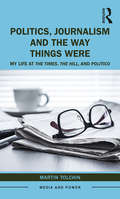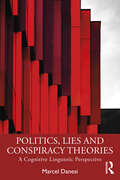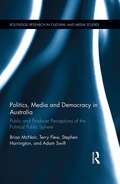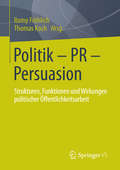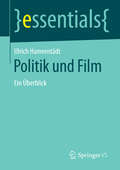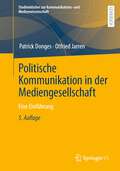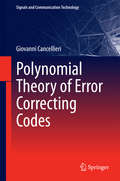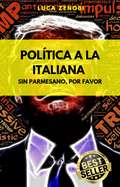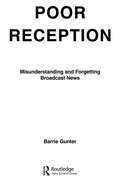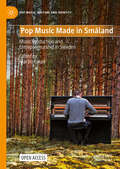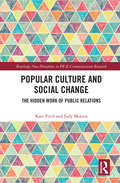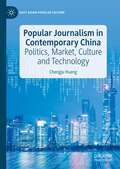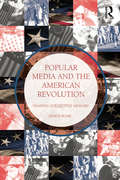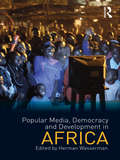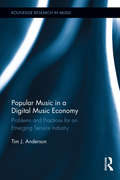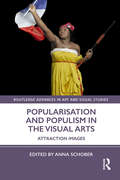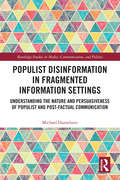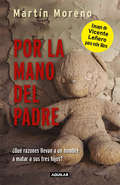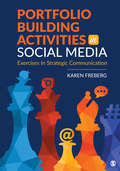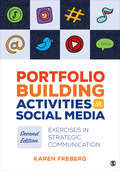- Table View
- List View
Politics, Journalism, and The Way Things Were: My Life at The Times, The Hill, and Politico (Media and Power)
by Martin TolchinIn this book, Martin Tolchin describes his journey from New York Times copy boy to White House correspondent, and as founder of The Hill and co-founder of Politico. He tells of the talented and eccentric colleagues he encountered en route, and the conflicts and tensions that beset him during his 40-year news career. Along the way, he tracks the evolution of political journalism from mostly all-male, smoke-filled newsrooms to the high-tech world of the 24/7 news cycle. As a local reporter in New York City, Tolchin saw his articles change public policy and re-direct millions of dollars in public funds. Nationally, Tolchin reported on some of the country’s most important political leaders, including Ronald Reagan, Jimmy Carter, and Tip O’Neill, among many others. As a Washington correspondent he was involved in Iran Contra, the Anita Hill hearings on the nomination of Justice Clarence Thomas, and Washington’s response to the New York City financial crisis. Mr. Tolchin writes with extraordinary candor and optimism. His story is one that will inform and inspire students, scholars, and general readers in an era in which fake news has sometimes overtaken legitimate reporting. He believes in the power of a free press to guard and guide free people.
Politics, Lies and Conspiracy Theories: A Cognitive Linguistic Perspective
by Marcel DanesiPolitics, Lies and Conspiracy Theories: A Cognitive Linguistic Perspective shows how language influences mechanisms of cognition, perception, and belief, and by extension its power to manipulate thoughts and beliefs. This exciting and original work is the first to apply cognitive linguistics to the analysis of political lies and conspiracy theories, both of which have flourished in the internet age and which many argue are threatening democracy. It unravels the verbal mechanisms that make these "different truths" so effective and proliferative, dissecting the verbal structures (metaphor, irony, connotative implications, etc.) of a variety of real-life cases concerning politicians, conspiracy theorists, and influencers. Marcel Danesi goes on to demonstrate how these linguistic structures "switch on" or "switch off" alternative mind worlds. This book is essential reading for students of cognitive linguistics and will enrich the studies of any student or researcher in language and linguistics more broadly, as well as discourse analysis, rhetoric, or political science.
Politics, Media and Democracy in Australia: Public and Producer Perceptions of the Political Public Sphere (Routledge Research in Cultural and Media Studies)
by Terry Flew Adam Swift Stephen Harrington Brian McNairIn Australia, as in many comparable democracies, the role of the media in the political process is high on the public agenda. There is a perception of widespread disillusionment with and disengagement from politics amongst voters, and criticism of the media for failing to fulfil their democratic responsibilities adequately. This book evaluates public perceptions of the performance of the political media in the context of the declared aims and objectives of media producers. From there the authors present findings for improving the capacity of political media to engage and inform their audiences in ways which enhance the quality and popular legitimacy of the democratic process. These conclusions are of import not only to Australians, but to observers of mediated politics in the UK, the US and other countries where similar debates around the ‘crisis of public communication’ are on-going.
Politik - PR - Persuasion
by Romy Fröhlich Thomas KochEin Thema steht auch in wahlkampffreien Phasen immer wieder gerne im Fokus der Medien: Das Verhältnis zwischen Politik und Public Relations. Die Bandbreite reicht von kritischen Berichten über vermeintlich unethische bis illegale Verquickungen zwischen beiden, über die Kritik an der Tatsache, dass die Politik öffentliche Gelder für Kommunikationsdienstleister ausgibt oder über den Einfluss kollektiver und individueller Interessensvertreter auf politische Entscheidungsprozesse (z. B. Stuttgart 21) bis hin zur zuweilen stark skandalisierenden Berichterstattung über Aufträge an PR-Agenturen, bestimmte Spitzenpolitiker wirksam zu inszenieren. Der massenmedialen Aufmerksamkeit im Umgang mit diesem Thema steht die Tatsache gegenüber, dass die wissenschaftliche Auseinandersetzung damit im deutschsprachigen Raum noch eher ein stiefmütterliches Dasein fristet. Mit diesen Beiträgen werden die übergreifende Bandbreite und die Foci relevanter nationaler und internationaler Forschung und Literatur zum Thema gebündelt und zugänglich gemacht (,,mapping"). So kann das Buch für Wissenschaftler aber auch für Studierende, die sich mit dem Thema "Politik und Public Relations" beschäftigen, zu einer Art "key point of reference" für aktuellste und bisherige Forschung zum Thema werden
Politik und Film: Ein Überblick (essentials)
by Ulrich HamenstädtDieses Essential bietet einen Überblick zu unterschiedlichen Interpretationen der Verbindung zwischen Politik und Film. Filme und Fernsehserien werden dabei als wichtige Darstellungsformen von Politik begriffen. In zahlreichen Formaten wird dies in den letzten Jahren deutlich. Interessant wird es jedoch, wenn Filme und Serien nicht den Anspruch erheben politisch zu sein, dies jedoch implizit sind. Denn Filme spielen zum einen immer mit Vorannahmen des Publikums, produzieren andererseits aber auch spezifische politische Annahmen und Weltanschauungen bei ihrem Publikum. So sind beispielsweise Ängste oder gesellschaftlich verbreitete Feindbilder für die Wirkung von Filmen bedeutungsvoll. James Bond bekommt heute keine Liebesgrüße mehr aus Moskau, dafür rücken Cyberangriffe und die zunehmende Macht Chinas in den Mittelpunkt der Filmreihe.
Politische Kommunikation in der Mediengesellschaft: Eine Einführung (Studienbücher zur Kommunikations- und Medienwissenschaft)
by Patrick Donges Otfried JarrenPolitische Kommunikation in der Mediengesellschaft ist ein komplexer und vielschichtiger Forschungsgegenstand. Das Lehrbuch legt den Schwerpunkt auf die Strukturen, Akteure und Prozesse politischer Kommunikation und analysiert diese aus einer kommunikationswissenschaftlichen Perspektive unter Berücksichtigung der Theorie- und Forschungsbestände anderer Sozialwissenschaften. Politische Medieninhalte werden als das Ergebnis von Interaktionsprozessen verstanden, die im Rahmen von Strukturen der Politik wie der Medien zwischen politischen und medialen Akteuren stattfinden. Dabei wird der Mesoebene der Organisationen wie der Makroebene der Gesellschaft besondere Aufmerksamkeit geschenkt, da politische Kommunikation in erster Linie eine organisierte Form der Kommunikation ist – sowohl auf Seiten der Politik wie auch auf Seiten der Medien. Gegenüber der zweiten Auflage wurde das Lehrbuch grundlegend aktualisiert, gestrafft und neu strukturiert.
Politisierung des Theaters und Theatralisierung der Politik im Nationalsozialismus: Müthels „Hamlet“-Inszenierung und Riefenstahls „Triumph des Willens“ (Szene & Horizont. Theaterwissenschaftliche Studien #13)
by Silke Christiane KleineVorliegende Arbeit beschäftigt sich mit den Fragen nach der Politisierung der Bühne während des „Dritten Reiches“ und der Nutzbarmachung theatraler Operativität für die politische nationalsozialistische Massenversammlung anhand der Analysen einer massenwirksamen Hamlet-Inszenierung (Lothar Müthel, Berlin 1936) und von Leni Riefenstahls filmischer Dokumentation des „Reichsparteitags der Einheit und Stärke“ 1934 („Triumph des Willens“). Während sich das Medium der Theaterbühne als nicht sonderlich fruchtbar für propagandistische Zwecke erwiesen hatte, ereignete sich das „eigentliche“ Theater des „Dritten Reiches“ auf den Plätzen und in den Arenen des politischen Massenauftritts. Es geschah also ein Transfer theatraler Mittel und Operativität hin zu öffentlichen Massenveranstaltungen des Regimes. Theatrale, dramaturgische Elemente der Theaterbühne erwiesen sich in Kombination mit massenpsychologischen Grundmechanismen als besonders tragfähig, sodass man sagen kann, dass es sich bei NS-tendenziösen Theaterinszenierungen um Präfigurationen des politischen Massenauftritts handelte. Dies wird anhand öffentlicher Veranstaltungen im Nationalsozialismus erörtert; diese werden im Hinblick auf theatrale Kategorien wie der Ausgestaltung/Architektur des Raumes, Auditivität (Stimme und Rede, die Rolle der Lautsprechertechnologie), Licht/Beleuchtung und Requisiten analysiert. Neben diesen Aspekten der Theaterregie kamen (hier: pseudo-) religiöse Aspekte der Kirchenregie zum Tragen. Leni Riefenstahls filmische Dokumentation „Triumph des Willens“ zeigt eindrücklich die Kulmination der bis dato in vielen Auftritten erprobten massenpsychologischen Dramaturgie im Großereignis von Nürnberg. Zudem entgrenzt Riefenstahl das Ereignis durch die Reproduzierbarkeit des Mediums „Film“. Einerseits stellt der Film den Initiationsprozess für die jungen Nationalsozialisten auf dem „Reichsparteitag“ in Nürnberg dar, andererseits war die „Lektüre“ des Films gleichsam ein Initiationsprozess für den Zuschauer; das filmische Zeugnis Leni Riefenstahls konnte so die Präsenzteilnahme am „Reichsparteitag der Einheit und Stärke“ ersetzen.
Polynomial Theory of Error Correcting Codes
by Giovanni CancellieriThe book offers an original view on channel coding, based on a unitary approach to block and convolutional codes for error correction. It presents both new concepts and new families of codes. For example, lengthened and modified lengthened cyclic codes are introduced as a bridge towards time-invariant convolutional codes and their extension to time-varying versions. The novel families of codes include turbo codes and low-density parity check (LDPC) codes, the features of which are justified from the structural properties of the component codes. Design procedures for regular LDPC codes are proposed, supported by the presented theory. Quasi-cyclic LDPC codes, in block or convolutional form, represent one of the most original contributions of the book. The use of more than 100 examples allows the reader gradually to gain an understanding of the theory, and the provision of a list of more than 150 definitions, indexed at the end of the book, permits rapid location of sought information.
Política A La Italiana: sin parmesano, por favor
by Luca ZenobiLa astucia y las competencias comunicativas seguramente ayudan a encontrar el camino más corto para llegar al corazón del elector. La verdad es que este tesoro a menudo no se comprende, intercambiando la política por la comunicación política. Así, nos encontramos personajes faltos de contenidos serios, incluso a menudo desinteresados en los contenidos serios, pero muy hábiles en la persuasión de masas. No importa lo que sea verdad, o lo que no sea verdad, lo que cuenta es lo que el personaje consiga emocionar al público. La buena noticia es que el pueblo italiano es creativo y después de Berlusconi, Grillo y Renzi, ya inventará algo nuevo sin lugar a dudas.
Poor Reception: Misunderstanding and Forgetting Broadcast News (Routledge Communication Series)
by Barrie GunterPublished in 1990, Poor Reception is a valuable contribution to the field of Communication Studies.
Pop Music Made in Småland: Music Production and Entrepreneurship in Sweden (Pop Music, Culture and Identity)
by Martin KnustUsing interviews with and academic studies of the careers of internationally-famous music producers and music industry professionals from Småland, Sweden, this open access book studies the history and present state of pop music production and entrepreneurship. An exceptionally high number of established and emerging pop artists and producers from this region of Sweden have had significant success on the international stage. This book describes how the situation for music producers and artists from Småland has changed during the past 50 years or so, starting in the 1970s with the so-called ‘Swedish music wonder’ and ending with the situation contemporary artists and entrepreneurs are facing. The field has changed massively both in terms of technology (from analogue to digital), social production (from individual productions to collective projects), distribution and marketing (from selling concert tickets and LPs to creating “prosuming” fanbases and multipronged careers considering genres, venues and activities). This book will be of interest to students of and professionals in music production; music, economy and media scholars; readers active in creative industries; and fans of (Swedish) pop music.
Popular Culture and Social Change: The Hidden Work of Public Relations (Routledge New Directions In Public Relations & Communication Ser.)
by Judy Motion Kate FitchPopular Culture and Social Change: The Hidden Work of Public Relations argues the complicated and contradictory relationship between public relations, popular culture and social change is a neglected theoretical project. Its diverse chapters identify ways in which public relations influences the production of popular culture and how alternative, often community-driven conceptualisations of public relations work can be harnessed for social change and in pursuit of social justice. This book opens up critical scholarship on public relations in that it moves beyond corporate understandings and perspectives to explore alternative and eclectic communicative cultures, in part to consider a more optimistic conceptualisation of public relations as a resource for progressive social change. Fitch and Motion began with an interest in identifying the ways in which public relations both draws on and influences the production of popular culture by creating, promoting and amplifying particular narratives and images. The chapters in this book consider how public relations creates popular cultures that are deeply compromised and commercialised, but at the same time can be harnessed to advocate for social change in supporting, reproducing, challenging or resisting the status quo. Drawing on critical and sociocultural perspectives, this book is an important resource for researchers, educators and students exploring public relations theory, strategic communication and promotional culture. It investigates the entanglement of public relations, popular culture and social change in different social, cultural and political contexts – from fashion and fortune telling to race activism and aesthetic labour – in order to better understand the (often subterranean) societal influence of public relations activity.
Popular Journalism in Contemporary China: Politics, Market, Culture and Technology (East Asian Popular Culture)
by Chengju HuangThis book, the first of its kind, investigates the historical trajectory and current situation of popular journalism in the People's Republic of China. Taking a popular cultural perspective, the book redefines “popular journalism” as a particular journalistic genre and media form and applies it to conceptualize popular journalism in the Chinese context. In particular, it examines how the dynamic and complex interplay of politics, the market, culture, and communication technology in shifting contexts has shaped the changing landscape of popular journalism in contemporary China. Meanwhile, regardless of how these factors might have changed over time, the fundamental nature of popular journalism as a source of fun and a troublemaker against elite powers in China, as in other places, has remained. The book further argues that the historical development of popular journalism in China forms an important and integral part of the country's social-cultural fabric and ultimately illustrates the mediated ideological and cultural struggle between popular/public and elite/state discourses in the country’s everyday social life in its challenging and discursive transition to modernity.
Popular Media and the American Revolution: Shaping Collective Memory
by Janice HumeThe American Revolution—an event that gave America its first real "story" as an independent nation, distinct from native and colonial origins—continues to live on in the public's memory, celebrated each year on July 4 with fireworks and other patriotic displays. But to identify as an American is to connect to a larger national narrative, one that begins in revolution. In Popular Media and the American Revolution, journalism historian Janice Hume examines the ways that generations of Americans have remembered and embraced the Revolution through magazines, newspapers, and digital media. Overall, Popular Media and the American Revolution demonstrates how the story and characters of the Revolution have been adjusted, adapted, and co-opted by popular media over the years, fostering a cultural identity whose founding narrative was sculpted, ultimately, in revolution. Examining press and popular media coverage of the war, wartime anniversaries, and the Founding Fathers (particularly, "uber-American hero" George Washington), Hume provides insights into the way that journalism can and has shaped a culture's evolving, collective memory of its past. Dr. Janice Hume is a professor and head of the Department of Journalism in the Grady College of Journalism and Mass Communication at the University of Georgia. She is author of Obituaries in American Culture (University Press of Mississippi, 2000) and co-author of Journalism in a Culture of Grief (Routledge, 2008).
Popular Media, Democracy and Development in Africa (Internationalizing Media Studies)
by Herman WassermanPopular Media, Democracy and Development in Africa examines the role that popular media could play to encourage political debate, provide information for development, or critique the very definitions of ‘democracy’ and ‘development’. Drawing on diverse case studies from various regions of the African continent, essays employ a range of theoretical and methodological approaches to ask critical questions about the potential of popular media to contribute to democratic culture, provide sites of resistance, or, conversely, act as agents for the spread of Americanized entertainment culture to the detriment of local traditions. A wide variety of media formats and platforms are discussed, ranging from radio and television to the Internet, mobile phones, street posters, film and music. As part of the Routledge series Internationalizing Media Studies, the book responds to the important challenge of broadening perspectives on media studies by bringing together a range of expert analyses of media in the African continent that will be of interest to students and scholars of media in Africa and further afield.
Popular Music in a Digital Music Economy: Problems and Practices for an Emerging Service Industry (Routledge Research in Music)
by Tim J. AndersonIn the late 1990s, the MP3 became the de facto standard for digital audio files and the networked computer began to claim a significant place in the lives of more and more listeners. The dovetailing of these two circumstances is the basis of a new mode of musical production and distribution where new practices emerge. This book is not a definitive statement about what the new music industry is. Rather, it is devoted to what this new industry is becoming by examining these practices as experiments, dedicated to negotiating what is replacing an "object based" industry oriented around the production and exchange of physical recordings. In this new economy, constant attention is paid to the production and licensing of intellectual property and the rise of the "social musician" who has been encouraged to become more entrepreneurial. Finally, every element of the industry now must consider a new type of audience, the "end user", and their productive and distributive capacities around which services and musicians must orient their practices and investments.
Popularisation and Populism in the Visual Arts: Attraction Images (Routledge Advances in Art and Visual Studies)
by Anna SchoberThis book investigates the pictorial figurations, aesthetic styles and visual tactics through which visual art and popular culture attempt to appeal to "all of us". One key figure these practices bring into play—the "everybody" (which stands for "all of us" and is sometimes a "new man" or a "new woman")—is discussed in an interdisciplinary way involving scholars from several European countries. A key aspect is how popularisation and communication practices—which can assume populist forms—operate in contemporary democracies and where their genealogies lie. A second focus is on the ambivalences of attraction, i.e. on the ways in which visual creations can evoke desire as well as hatred.
Populist Disinformation in Fragmented Information Settings: Understanding the Nature and Persuasiveness of Populist and Post-factual Communication (Routledge Studies in Media, Communication, and Politics)
by Michael HameleersIn this highly relevant work, Dr. Michael Hameleers illuminates the role of traditional and social media in shaping the political consequences of populism and disinformation in a mediatized era characterized by post-factual relativism and the perseverance of a populist zeitgeist. Using comparative empirical evidence collected in the US, the UK, and the Netherlands, this book explores the politics and discursive construction of populism and disinformation, how they co-occur, their effects on society, and the antidotes used to combat the consequences of these communicative phenomena. This book is an essential text for students and academics in communication, media studies, political science, sociology, and psychology.
Populist Political Communication in Europe (Routledge Research in Communication Studies)
by Carsten Reinemann Frank Esser Jesper Stromback Toril Aalberg Claes De VreeseIn an increasing number of countries around the world, populist leaders, political parties and movements have gained prominence and influence, either by electoral successes on their own or by influencing other political parties and the national political discourse. While it is widely acknowledged that the media and the role of communication more broadly are key to understanding the rise and success of populist leaders, parties and movements, there is however very little research on populist political communication, at least in the English-speaking research literature. Originating from a research project funded by the European Cooperation in the field of Scientific and Technical Research (COST), this book seeks to advance this research. It includes examinations 24 European countries, and focuses on three areas within the context of populism and populist political communication: populist actors as communicators, the media and populism and citizens and populism.
Por la mano del padre: ¿Qué razones llevan a un hombre a matar a sus tres hijos?
by Martín MorenoA partir de la trágica noticia de un hombre que mata a sus tres hijos pequeños para vengarse de su esposa, por una supuesta infidelidad, Martín Moreno elabora en este libro un reportaje devastador. Al estilo de A sangre fría, de Truman Capote, Las dos amigas y el envenenamiento, de Alfred Döblin o Los hijos de Sánchez, de Oscar Lewis, el autor de Por la mano del padre convierte la nota roja en un trabajo periodístico. Escarba en la más profunda intimidad del asesino: su contexto social fracturado, la relación familiar marcada por la miseria, el abismo del alcohol y las drogas, los rasgos psicológicos de los padres del acusado, de su pareja sentimental, de amigos y familiares que enmarcan este drama urbano. El gran mérito del autor de El derrumbe es alejarse del juicio inmediato de quienes condenan elcrimen para ofrecer una explicación severa del por qué se dan estos brotes de maldad, qué función juega el abandono infantil, la carencia económica y de afectos, y elabora el retrato del filicida sin afán de condenar o justificar, sólo para entregar un rostro estropeado por el vicio, el desamor, el núcleo familiar despedazado. Por la mano del padre es un libro implacable, pero también conmovedor; verdugo y condenados son una sola esencia, revelan que la mano del asesino no sólo es la maldad, también es el vacío existencial y una sociedad cada vez más violenta. Fragmento del ensayo de Vicente Leñero para este libro: "Versión actualísima de aquellos 'hijos de Sánchez' que Oscar Lewis siguió y registró minuciosamente a punta de grabaciones. El mural que hizo Lewis en los años sesenta fue juzgado y censurado como denigrante, cuando lo verdaderamente denigrante para México era el fenómeno mismo de aquella pobreza humana reflejada en su espejo literario. Lo mismo puede decirse, gracias a la investigación de Martín Moreno, de lo que Por la mano del padre se trasluce en pinceladas de estos barrios carcomidos en Ciudad Nezahualcóyotl, de esa gente que vive al día sin esperanza alguna de progreso."
Pornography: Research Advances and Policy Considerations (Routledge Communication Series)
by Jennings Bryant Dolf Zillmann"...provides good coverage of the empirical literature."—Journal of Communication "...well written and presents a wide diversity of approaches to pornography."—CHOICE
Port Out, Starboard Home: The Fascinating Stories We Tell About the words We Use
by Michael QuinionCan it really be true that 'golf' stands for 'Gentlemen Only Ladies Forbidden'? Or that 'rule of thumb' comes from an archaic legal principle that a man may chastise his wife, but only with a rod no thicker than his thumb?These and hundreds of other stories are commonly told and retold whenever people meet. They grow up in part because expressions are often genuinely mysterious. Why, for example, are satisfying meals 'square' rather than any other shape? And how did anyone ever come up with the idea that if you're competent at something you can 'cut the mustard'?Michael Quinion here retells many of the more bizarre tales, and explains their real origins where they're known. This is a fascinating treasure-trove of fiction and fact for anyone interested in language.
Portfolio Building Activities in Social Media: Exercises in Strategic Communication
by Karen FrebergFeaturing 50 real-world activities across various social media platforms! Portfolio Building Activities in Social Media shows you how to communicate on social media professionally and strategically by giving you hands-on experiences with real-world challenges. From brand analyses to budget assignments to pitch activities, this practical exercise guide offers you multiple opportunities to create and build your portfolio of work. Designed to be used with Freberg’s Social Media for Strategic Communication, but flexible enough to bundle with any PR textbook, these exercises are useful to any professor looking to incorporate more activities around social media and digital brand development.
Portfolio Building Activities in Social Media: Exercises in Strategic Communication
by Karen FrebergFeaturing 50 real-world activities across various social media platforms! Portfolio Building Activities in Social Media shows you how to communicate on social media professionally and strategically by giving you hands-on experiences with real-world challenges. From brand analyses to budget assignments to pitch activities, this practical exercise guide offers you multiple opportunities to create and build your portfolio of work. Designed to be used with Freberg’s Social Media for Strategic Communication, but flexible enough to bundle with any PR textbook, these exercises are useful to any professor looking to incorporate more activities around social media and digital brand development.
Portfolio Building Activities in Social Media: Exercises in Strategic Communication
by Karen FrebergFeaturing 125 real-world activities across various social media platforms! Portfolio Building Activities in Social Media shows students how to communicate on social media professionally and strategically by giving them hands-on experiences with real-world challenges. From brand analyses to budget assignments to pitch activities, this practical exercise guide offers students multiple opportunities to create and build their portfolio of work. Designed to be used with Freberg’s Social Media for Strategic Communication, but flexible enough to bundle with any PR textbook, these exercises are useful to any professor looking to incorporate more activities around social media and digital brand development.
